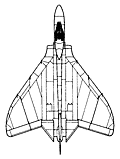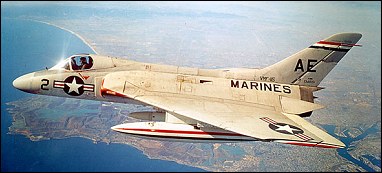|
| US Navy interest in German delta-wing research led, in 1947, to the design by Douglas of a carrier-based interceptor which embodied a variation of the pure delta wing. Approval of the Douglas design was signified by the award of a contract for two Douglas XF4D-1 prototypes on 16 December 1948, the first making its maiden flight on 23 January 1951 powered by a 2268kg thrust Allison J35-A-17 engine. This represented an emergency powerplant, resulting from delays in development of the Westinghouse J40 turbojet which had been the planned engine. Both prototypes were flown subsequently with the XJ40-WE-6 developing 3175kg thrust and the XJ40-WE-8 which had a rating of 5262kg with afterburning, but problems with this engine programme led to final selection of the Pratt & Whitney J57 engine for production aircraft.
The F4D Skyray was a cantilever mid-wing monoplane, the wing of modified delta configuration incorporating elevons to serve collectively as elevators or differentially as ailerons. The tail unit had only swept vertical surfaces, landing gear was of retractable tricycle-type and the pilot was accommodated well forward of the wing in an enclosed cockpit that provided excellent visibility.
The potential of the F4D was demonstrated effectively by the second prototype on 3 October. 1953, then powered by the XJ40-WE-8 turbojet, which set a new world speed record of 1211.746km/h. The first production F4D-1 was flown on 5 June 1954, powered by a Pratt & Whitney J57-P-2 turbojet developing 6123kg thrust with afterburning, but it was not until 16 April 1956 that deliveries began, initially to US Navy Squadron VC-3. The 419th and last production aircraft was delivered on 22 December 1958, but in the intervening period a change had been made by installation of the higher-rated J57-P-8 engine. All aircraft retained the F4D-1 designation, the popular (derived) name being Ford.
At the peak of its utilisation, the Skyray equipped 11 US Navy, six US Marine and three reserve squadrons, but none was used operationally. The type survived in first-line service until the late 1960s, with two front-line squadrons not converting to the type until 1964. It was redesignated F-6A in September 1962.

| MODEL | F4D |
| CREW | 1 |
| ENGINE | 1 x Pratt & Whitney J57-P-8B turbo-jet, 64.5kN with afterburner |
| WEIGHTS |
| Take-off weight | 11340 kg | 25001 lb |
| Empty weight | 7268 kg | 16023 lb |
| DIMENSIONS |
| Wingspan | 10.21 m | 34 ft 6 in |
| Length | 13.93 m | 46 ft 8 in |
| Height | 3.96 m | 13 ft 0 in |
| Wing area | 51.75 m2 | 557.03 sq ft |
| PERFORMANCE |
| Ceiling | 16765 m | 55000 ft |
| Range | 1931 km | 1200 miles |
| ARMAMENT | 4 x 20mm cannons, 1814kg of weapons on six hardpoints |
 | A three-view drawing (1693 x 1520) |
| Bob KNOTTS, PHCM, e-mail, 29.08.2010 02:21 We had a Marine F4D squadron "visiting" us at NAS Atsugi in 57 or 58. (VMF-451?)A marine mech accidently put his ac into afterburner during a turn up. It jumped the chocks, and started another F4D on fire. We lost two for the price of one. But I don't think anyone was injured. reply | | ROBERT F GAGNE, e-mail, 04.03.2010 19:08 WAS IN VFAW3 FROM 1957 TILL 1961. THIS WAS A GREAT AIRCRAFT TO WORK ON AND A GREAT SQUADRON TO BE IN. IT WAS ALSO THE GREATEST PLACE TO BE STATIONED. reply | | Bruce Wadleigh, e-mail, 31.01.2010 20:42 I was in VMF(AW)513 in 1960 thru 1962 under the command of Lt Col Dewey Durnford. The Skyray was our bird and a fine bird it was. I worked on all of the avionics systems on land and at sea on aircraft carriers both CONUS and FMFPAC.
I miss those days a lot. Semper Fi !!! reply | | John Brickner, e-mail, 31.01.2010 05:28 Loved the "FORD"! A little Hot Rod! Really impressed the ladies with those high performance after-burner sunset take-offs at Oceana. Can't do that anymore. It was a ZIP for a young Ensign to outturn the poor Crusader in ACM. I flew off the Forrestal, VF-102 Diamonbacks '59 /'60. I shudder when I remember that dark hole for night traps---no moon glows then, but the Ford always came thru for me.
One night in Key West, I took her to 50k and pointed her straight down to see just how fast she would go. Got to 1.25 Mach, pulled out by 10K.
Then there was the "tranducer". It never worked. At transonic speeds you could wipe out the cockpit with the stick and nothin' happened. Or it might tuck at Mach 1, so you pushed and pulled riding the 'bronco' until you slowed down. Spent the next 15 years with the new F-4. John B reply | |
| | Lawrence Bailey, e-mail, 14.01.2010 00:46 I flew the Ford in '57-58 in VFAW-3, checking out new pilots in the last months of my tour. It was a handful, especially before the TTC (Transonic Trim Changer) arrived; but the most fun you could have outside of bed. Angle of attack and the gage that displayed it were new concepts in the Ford and several 'old timers' were sceptical, believing that airspeed was the only Holy Grail of flying. Aircraft design was going foreward at a great pace in the '50's. Connical camber, a knife edge windshield, the new G.E. J-79 eng and the area rule would make the F4D-1 obsolete by the '60's. But is was so pretty and perhaps one of the most manuverable aircraft ever made, (560 degrees rate of roll if I recall). For an instant in time she was a trail blazer. reply | | Philip Witmer, e-mail, 05.01.2010 22:13 My father flew the F4D in 1955 as the CO of VF101 in Key West, Fl and later in Jacksonville, FL. The squadron was carrier qualified while there. It is my understanding that this was the first operational supersonic squadron in the Navy. reply | | Doug Mount, e-mail, 30.12.2009 03:04 I was a plane captain on the F4D Skyray in CAG-21 VF-213 at NAS Moffet Field CA. 1957 & 1958 It was a good plane to work on,low maintence. reply | | Wayne Wallace, e-mail, 27.09.2009 20:29 Personnel man VF-23 Commander C. A. Knight ex Blue Angel, our squadron Commander. He taught our pilots the art of flying. Example when we were in Fallon Nevada. 15 aircraft all took to the air. One of my jobs was to get the Marine detachment there to be out on the field to watch a fly by of our aircraft. It was not a fly-by, it was 15 aircraft coming from every direction to the center of the field, and at a given time they all hit after burner and disappeared into the sky. Seconds later they came by in the fly-by that was promised. Will never forget it! Also, one of our pilots bailed out below 5,000 feet from the F-4 in the Bay Area of SF. The first one to do so. reply | | Bob Hazlett, e-mail, 18.09.2008 23:22 I was an Air Force exchange pilot attached to VF141, the Iron Angles. I flew the F4D, "Ford" in 1957 and 1958. I deployed to the Pacific on the Bonne Homme Richard for six months in 1957. reply | | Bruce Martin, e-mail, 14.07.2008 05:29 I flew the F4D in my first squadron after completing flight training in 1958. We operated out of Cherry point NC, and in the spring of 1959 moved the squadron to Atsugi Japan where we picked up an air defense commitment with the 41st Air Division out of Yokota AFB. We flew day and night intercepts usually against Russian Bears and Bison aircraft that would come down from Siberia. The F4D had a fine radar, the APQ-50, that could pick up targets well over 100 miles away. Climb capability was another strong point with the aircraft. We also operated out of Cubi Point in the Philippines, Ping Tung North in Taiwan and twice aboard ship. Shipboard ops were pretty straight forward although the aircraft had a slight yaw, (Dutch Roll), tendency on final approach that looked much worse from the LSO platform than it did from the cockpit. I thought it was a very good aircraft to fly, especially without drop tanks. reply | | Art McMahon, e-mail, 11.07.2008 21:48 I was attached to the Provost Marshalls Office (MP) at Ping Tung, Formosa in 1958. It was always a thrill, as I was posting the guard on the flight line, to watch the pilots send these planes skyward. The real thrill was to listen to the Chinese National pilots who flew the F-86 Sabre Jet----now that's "another story". reply | | george perry, e-mail, 31.05.2008 15:57 I flew the F4D SkyRay from late 1959 until 1962 with VMF(AW)114 and VMF(AW)531, the plane was great though it's mission was too defined and didn't leave room for many applications. I accumulated almost a 1000 hours in the plane and enjoyed them all. reply | | Charles Delavan, e-mail, 14.05.2008 05:22 I was in Design Engineering on this air;lane most of the timefrom early preliminary design until production phase out. I understand that the XF$D took two Sorld speed records and the F$D-!dmonstrated its capbility of taking other world performance records. The Nav would not allow it to be made official until the end of it's active service. reply | | Jaime Alexander, e-mail, 13.05.2008 05:39 Flew it with VFAW3 in '58-'59. Mission was Air Defense for NORAD. It replaced the F3D for us in that mission and was a huge increase in performance. The handwriting was on the wall though as many designs incorporating better transonic and supersonic performance were appearing in service. It will go higher than the "ceiling" of 55000. reply | |
| | bigredlancer, e-mail, 03.05.2008 00:32 USS Intrepid still had VF-74 "Be-Devilers' F4D-1s on the 60-61 Med Cruise...
JJ
VFP-62 Det 33-60 F8U-1Ps USS Intrepid CVA-11 reply | | Jim Campbell, e-mail, 28.04.2008 02:55 I flew Fords from March 1958 to December 1960 with VMF (aw)-314 and 513. I really enjoyed the aircraft and never had any problems in flying it. It was a fun bird and I was sad to see it go though it's mission had been largely overtaken by newer designs. reply | | Jim Bassett, e-mail, 02.04.2008 00:24 The F4D was gone from 1st line Navy squadrons by the end of the 50's. replaced by F8U crusaders and F3H Demons.A few were around in test and other units. reply | | oren yehuda, e-mail, 03.05.2007 20:17 what will be the main diferents between the skyray and the skylancer reply |
|
Do you have any comments?
|
| 
COMPANY
PROFILE
All the World's Rotorcraft
|








